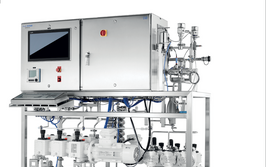Room for Improvement
Today’s cleanrooms may meet current quality standards, but what about the future? Opportunities for improvement can be found in all areas, from gowning to cleaning to implementing robotics technology.

We recently came across a survey that asked, how has cleanroom technology and environmental monitoring changed? And the more we thought about it, the more we realized that not a lot has changed.
It’s well-known that the pharma industry does not like to rush into change, but it’s also true that advances have been made in contamination prevention technologies that could provide improvements in pharma’s cleanrooms. Perhaps one of the biggest advances to impact cleanrooms is the development of isolators and restricted access barrier systems (RABS). However, even the adoption of this technology has been painfully slow in pharma compared with other industries. Adopting new technology always involves upfront costs – and cleanroom downtime, which can be problematic, and pharma companies also have a habit of being wary with any new technology. It is true that some new technologies may have teething issues. For example, there have been concerns with leaky isolator gloves. However, we have also seen advances to address this, such as rubber materials manufactured in Asia that are designated “leak-proof.” In time, perhaps these materials will see greater use in the industry.
In this article, we aim to give a short overview of some of the ways in which cleanrooms could be improved. Writing about each area in depth would fill a whole magazine a dozen times over, but perhaps these pointers will encourage you to dig a little deeper.
Dressing the part
Humans are the biggest sources of contamination in a cleanroom (1). The outer layer of the human skin alone can host more than one million microorganisms per square centimeter (2). Gowning helps to prevent these microorganism from reaching the cleanroom and is a relatively easy area to invest in compared with infrastructure changes. However, garments can only minimize the chances of contamination; it is almost impossible to completely prevent it.
The gowning area is where operators change into their cleanroom garments. Gowning procedures will vary from company to company (and depending on the class of cleanroom), but over time, the gowning area itself can become contaminated. There are a number of technologies that could be used in gowning rooms. First of all, lockers, benches and other surfaces could be painted with antibacterial and antifungal paints; many of these paints use nanoparticles (for example, silver) that are antifungal and antibacterial.
Most cleanrooms require people to wear gowns/overalls, shoes (or covers), hairnets and goggles. If you look at gowns offered by vendors, you’ll see that there have been numerous advances in gowning materials – many of which are based on nanotechnology – to create non-shedding garments. There are materials that keep moisture in, keep moisture out, are antibacterial or antifungal (or both), keep odors in, are water and stain resistant, difficult to rip or tear... the list goes on. New methods for folding and packaging gowns have also been developed that can reduce risk. For example, some vendors fold their gowns in a way that reduces the likelihood of the outside surface touching the floor during donning of the uniform.
Ask yourself when the gowns in your cleanroom were last updated. Never?! Remember that gowns are getting smarter all of the time. Some even incorporate RFID chips that track the frequency of washing cycles.
Shoes can be a problem in a cleanroom. Shoes can be a significant source of contamination because shoes travel everywhere. Some companies still use shoe covers, but contamination can pass to gloves, hands or other areas when donning the covers. And the covers themselves can also come loose (I’ve seen a visitor to a cleanroom facility walking around with a shoe cover half on, half off more than once). Some companies issue plant shoes for employees to wear, but these shoes can still make it into the cafeteria or elsewhere in a facility. Some pharmaceutical applications utilize rubber boots that can be worn over shoes, but they can also be a source of contamination if they are not routinely cleaned and disinfected. In fact, various sterilization and decontamination methods exist, such as chemical disinfectants, but they are rarely employed simply because most people just don’t understand the risks. Goggles are usually sanitized with ultraviolet light, but chemical sterilants, such as ozonated water, can be used, or nanomaterials can make them “self cleaning.” This could also reduce the risk of contamination.
Wash your hands!
The link between washing hands and hygiene has been known since the 19th century (3). And those of us working in cleanrooms today know that we should wash our hands for at least 20 seconds, but we suspect that few follow the full procedure. Luckily, there are ways to clean hands faster; for example, using ozonated water can shorten the time needed to eliminate contamination present on skin. Ozonated water also is effective at ambient temperatures, which makes it useful for areas where hot water is in short supply. It’s one example of something that has been used for years in the food services industry, both for employee hands and the foods themselves, but is not well used in the pharma industry.
Once hands are washed, they must be dried. Some companies prefer to use cleanroom-safe paper towels, others cloth towels, and then there are air dryers. Many believe air driers are better for contamination control, but a recent study claimed that a common type of air hand drier spread more germs than paper towels because it propels the bacteria into the air (4). All drying methods can lead to additional sources of contamination, so it is important to recognize the strengths and weaknesses of the system you choose to use and to mitigate the risks. Whatever solution you choose, you must ensure that employees follow procedures.
Facility makeover
Making changes to an actual cleanroom facility is more difficult than updating gowning materials. New cleanroom facilities are being built all of the time, which gives the opportunity for improvement, but there are also a number of existing, well-established cleanrooms with stainless steel infrastructure. Many old cleanrooms are still compliant with regulations, but others can run into problems. An example of this was seen in 2015, when the FDA identified sterility problems at the Clinical Center Pharmacy of the National Institute of Health. Garment-related issues were identified, such as protective apparel not being worn as necessary, but there was also an observation about the facility design: “Specifically, facilities were not designed and controlled to prevent contamination risks… there is inadequate separation of the aseptic processing area from the common pharmacy.” (5)
In light of this, it’s always worth reviewing an older cleanroom for potential problems and to evaluate if new advances can help.
Isolators and RABS have been in existence for many years, but it’s incredible just how few companies have actually installed these systems in their sterile operations in the United States – leaning towards the ‘if it ain’t broke, don’t fix it’ mentality. Many companies will not spend the money if their current system is already compliant, even if it is not the most efficient. In our experience, we’ve found that Europe and Asia have been ahead of the US when it comes to implementing these technologies, particularly when it comes to building new facilities.
Likewise, single-use systems are not as readily used as one would expect, even though such technologies have the benefits of being purchased sterile, used for one production batch, and then discarded, eliminating the need for cleaning. Although single-use is now well established in biopharma manufacturing, it is very much underused by generic and small-molecule drug manufacturers. There are benefits to using single use in a cleanroom, even for non-biopharma drugs. For example, it is possible to save all containers until batch release, so that if you believe a contamination event occurred at a particular stage of the process, you can sample the single-use system used to confirm or deny any contamination.
Top Cleanroom Advances
Tim Sandle is the head of microbiology at Bio Products Laboratory (UK) and a tutor at the University of Manchester, specializing in microbiology, cleanrooms and sterilization. According to Sandle, one overriding concern with cleanrooms and cleanroom technology is maintaining product or operator protection. The drivers for developing cleanroom technology are to increase the level of protection or to decrease operational costs – but it is crucial that the latter does not impinge on the former. Here, Sandle gives a rundown of his top advances in cleanrooms in recent years.
Design
It is important to dedicate time to designing cleanrooms and the equipment located in cleanrooms. If there is a design fault at the conception stage, it will be expensive and time consuming to rectify. Modern cleanroom design uses computer-aided engineering progams, such as Building Information Modeling (BIM) software, which covers geometry, spatial relationships, light analysis, geographic information, quantities and properties of building components. Cleanroom design should also form part of the broad ‘Quality by Design’ initiative.
Construction and the modular concept
Recent advances in construction ensure that cleanrooms are built to a higher standard in terms of reducing contamination risks. For example, plasma welding can be used for potentially weaker areas, like ventilation ducting, to ensure improved leak tightness (a leak of air from a less clean area into the cleanroom is a major contamination risk). Another development is the use of ‘double skin’ constructions around air-handling units, which also minimizes air leakage.
Traditional cleanroom design is sometimes described as “hard-walled” or “hard-lidded.” Softer walled modular designs are a more recent development. Modular cleanrooms offer the advantage of fast construction, normally at a lower cost, and allow users of cleanrooms to expand their clean area footprint relatively easily, which explains their popularity. Modular cleanrooms also offer more flexibility – and flexible designs are important, especially for small-scale or emerging technologies, such as biotechnology.
Isolators and RABS
A key advancement in cleanroom technology, in terms of contamination control, is barrier technologies, such as isolators and restricted access barrier systems (RABS). In areas, such as aseptic filling of sterile drug products, such technology is being adopted to replace conventional cleanrooms. Isolators and RABS restrict operator access to the most critical areas of machinery. Of the two, the isolator provides the most complete barrier and is the superior technology. Arguably the most important contamination control step is the decontamination of the isolator environment. Here, the use of vaporized hydrogen peroxide (VHP) is the most common method.
Robotics
Given that human manipulations and interventions in the critical zone within the clean space represent the greatest risk, reducing the need for human intervention to the lowest possible level is an important part of contamination control. To a degree, this can be achieved with automation and robotics. Robotics is still in its infancy but can provide many benefits. As well as reducing human interaction, robotics ensure that activities are undertaken in a consistent manner and also provide a means of adapting the mechanical operation to suit the filling of different types of products. If designed correctly, robotics will not generate a high level of airborne particles and can be sanitized using disinfectants.
Energy conservation
There have been a number of global initiatives around energy efficiency in cleanrooms, such as the EN 16001 standard. Energy efficiency provides a means for cleanroom users to meet energy targets and save costs. Advances in microcomputing also allow the motors that drive cleanroom air conditioning systems to be dynamically self-adjusting, whereby the airflow adjusts in relation to changes in pressure or to the filter loading (particle challenge).
Antibacterial materials
An important preventative measure for contamination control is the use of antibacterial materials to coat cleanroom surfaces (sometimes referred to as “biotrunking”). Such surfaces include stainless steel, where silver or copper can be introduced into the steel surface. An advantage of silver ions is that, although they have antimicrobial properties, they are rarely toxic to human cells.
Robotics are used in many manufacturing industries for picking, placing and packing – and can also be fitted with camera systems to allow operators to see the process (remotely, in some cases). Robots are making their way into the pharma industry, most notably in terms of lab automation and drug discovery (robots can screen thousands more potential drugs than any human can), but they are also increasingly found in cleanrooms and have the huge benefit of almost completely eliminating human intervention – and the potential for contamination. However, we don’t believe that robots are being used as much as they should be – and they are certainly capable of so much more. One growing application in the industry is using robotics for filling RABS units.
Every little counts
Investing in new technology is not the only way to improve a cleanroom. What about using antifungal sprays on walls and surfaces? Sprays can coat the surface, forming a hydrophobic barrier that attracts – and kills – mold spores. Depending upon the cleaning regimens used in these rooms, the sprays can be effective for a year or more. Importantly, don’t forget your air ducts. Air ducts are notorious for harboring mold spores and antifungals can make a big difference. As an industry, we tend to trust HEPA filters to remove these, but small sections of mold have been shown in studies to pass through a typical HEPA filter and, given the right conditions, subsequently grow in the cleanroom. Antifungal paints can also be used on floors and walls.
When it comes to cleaning, pharma companies like to stick with tried and tested. But the area of cleaning and disinfection has seen many advances and many newer options are not used – or even known about – because most companies haven’t considered an alternative. The problem with many current cleaning methods is that they can leave residue, which some operators mistakenly believe is a good thing because it means the product is “still disinfecting.” Residue should be removed with specialist paper towels based on nanotechnology. There are also towel wipes that are designed to “rejuvenate” stainless steel surfaces, making them look new. And though it may simply sound like an aesthetic problem, recently there has been a lot of regulatory focus on the famous black, brown, rust-like or mold-like particles.
It’s quite easy to be innovative when it comes to cleaning products in the pharma industry; after all, many new technologies aren’t typically used in pharma’s cleanrooms, including hydrogen activated water, ozonated water, chlorine dioxide and nitrogen dioxide – all of which achieve the right level of sterilization without leaving a residue. It’s not as difficult as you might expect to change cleaning and disinfecting procedures; all that is required are some effectiveness studies.
Environmental monitoring is another area ripe for improvement. For the most part, the pharma industry uses microbiology lab methods that have changed very little since the days of Pasteur and Koch. Recently, rapid and alternative microbiological methods (RMMs) have emerged but uptake in the industry has been slow (6). Today, RMMs tend only to be used sparingly for training or for supporting investigations. In most cases, RMM results can be obtained in real time or near real time. The cost of RMM technologies is falling and in our opinion, RMMs will see better uptake in the cleanrooms of the future.
When it comes to environmental monitoring data, there are many tools available, from control charts to standard limit tests to contamination control rates. Vendors have developed automated systems to monitor and assess environmental data, and though some of these are expensive, there are now a number of cheaper alternatives. It’s surprising how many companies are still using spreadsheets and home-grown databases...
The effort that goes into environmental monitoring is also up for debate. Many operators performing routine environmental monitoring in well-kept facilities are used to seeing zeros on plates in aseptic areas. And yet the current level of monitoring must be maintained. If environmental monitoring was truly risk-based, then it would make sense to reduce the type of monitoring conducted... The subject of environmental monitoring is a whole article unto itself (as are all of the topics discussed here).
We hope we have shown that there is much more that can be done to improve your cleanrooms – and in some cases, all that’s needed is an open mind and an eye for detail.
- T Sandle, Institute of Validation Technology, “Peer Reviewed: Cleanroom Contamination”, (2014). Available at: bit.ly/2beVls0. Accessed August 10, 2016.
- E Proksch, JM Brandner and JM Jensen, “The Skin: An Indispensable Barrier”, Exp Dermatol 12, 1063-72 (2008). PMID: 19043850.
- Centers for Disease Control and Prevention, “Guideline for Hand Hygiene in Health-Care Settings”, (2002). Available at: bit.ly/2b7Es3l. Accessed August 10, 2016.
- EL Best, P Parnell and MH Wilcox, “Microbiological Comparison of Hand-Drying Methods: the Potential for Contamination of the Environment, User, and Bystander”, Journal of Hospital Infection 88, 199–206 (2014). PMID: 25237036
- FDA, Letter Sent to Mr Robert DeChristoforo, Chief Pharmacy Department at the NIH – Clinical Pharmacy Center (2015). Available at: bit.ly/1I3lkre. Accessed August 10, 2016.
- T Sandle, “Embracing Rapid Microbiology”, The Medicine Maker, 11, (2015). Available at: bit.ly/1I3lkre.
Brian G Hubka is CEO of Contamination Prevention Technologies.
Jeanne Moldenhauer is Vice President of Excellent Pharma Consulting. She serves on Scientific Advisory Boards for a number of companies in the area of rapid microbiology.


















